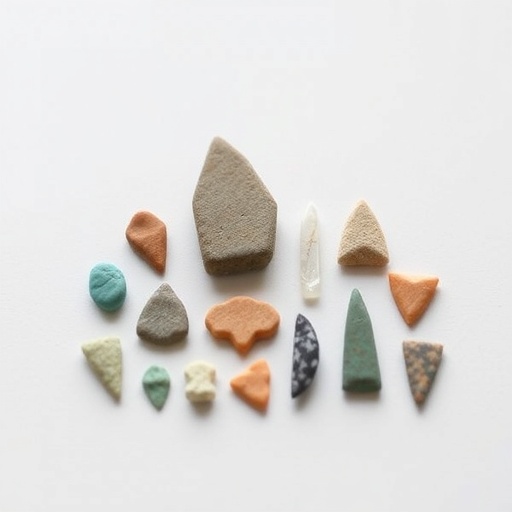In recent decades, the significance of miniaturized lithic technologies in human prehistory has garnered increasing scholarly attention. However, South China, a region pivotal to understanding human adaptation, has remained relatively understudied in this context. A transformative new study, recently published in the Journal of Geographical Sciences, bridges this gap by providing an unprecedented multivariate analysis of lithic miniaturization spanning from the terminal Pleistocene to the middle Holocene. The research utilizes advanced statistical methodologies alongside traditional typological examination, setting a new benchmark for archaeological investigations in East Asia.
Human populations during the Late Pleistocene embraced an astonishing array of stone tool technologies adapted to diverse environments. While northern China’s microblade industries have been extensively documented, South China’s lithic record was traditionally characterized by larger cobble tools, leading to assumptions about technological stasis in the region. This new investigation, however, challenges such views by uncovering evidence of sophisticated lithic miniaturization practices across several sites, contrasting previous paradigms and illustrating technological innovation as a central adaptive strategy rather than a peripheral curiosity.
The international collaboration, including researchers from the Institute of Vertebrate Paleontology and Paleoanthropology and partners from prestigious institutions such as Griffith University and the Smithsonian Institution, analyzed over 12,000 artifacts recovered from three key archaeological sites: Fodongdi (Yunnan), Fulin (Sichuan), and Xiqiaoshan (Guangdong). These sites encompass a wide temporal and ecological range, allowing for a dynamic exploration of lithic evolution in response to environmental and demographic forces across roughly 18,000 to 5,600 years before present.
At Fodongdi, situated in a tropical zone within Yunnan province, researchers identified 456 bipolar lithics. These pieces, mainly small quartz splinters, were produced through a systematic reduction strategy that emerged distinctly during the cool and resource-scarce Last Glacial Maximum. The choice of bipolar technique here enabled efficient exploitation of quartz pebbles, demonstrating an innovative means of resource maximization in a climatically constricted ecosystem—a testament to adaptive ingenuity under ecological duress.
Moving northward to Fulin, adjacent to the eastern margins of the Tibetan Plateau, the assemblage portrayed a different technological signature. Here, 222 bladelet-like flakes surfaced, dating to around the Younger Dryas—a period marked by rapid climatic fluctuations. These tiny blades were likely functional elements of composite hunting tools, designed to be lightweight, portable, and highly efficacious in a rugged highland environment. The Fulin assemblage thus encapsulates a specialized microblade industry, finely tuned to environmental exigencies and mobility requirements.
Finally, the Xiqiaoshan site in Guangdong represents a middle Holocene chapter in this lithic narrative. The assemblage, encompassing 387 microblades and their associated cores, displayed pronounced standardization and technological sophistication. Core forms ranged from wedge-shaped with single or double platforms to irregular variants, facilitating the production of elongated, sharp bladelets. This industry likely arose in response to demographic expansions, including migrations from northern territories, catalyzing cultural interchanges that promoted refinement and homogenization of lithic technology.
The application of multivariate techniques, such as Principal Component Analysis and K-means clustering, afforded the researchers a rigorous framework to discern patterns within the lithic data. Statistical clustering segregated artifacts into distinct technological groups rather than reflecting random variation or mere by-products of reduction sequences. This distinction is crucial, revealing intentional design parameters and deliberate technological choices behind the miniaturized toolkits, spotlighting human agency at the heart of prehistoric technological trajectories.
A salient trend across the temporal and spatial transect was the progressive shift toward increasingly standardized and elongated lithic forms. Notably, the average length-to-width ratio of these miniaturized elements increased, signaling an evolutionary refinement in shape optimization for heightened utility. This convergence vector underscores a shared adaptive logic among diverse prehistoric communities, tying the morphological characteristics of stone tools to broader survival imperatives amid shifting climates and resource distributions.
In sum, lithic miniaturization was not merely a sporadic or localized innovation within South China but represents a sustained, regionally diverse adaptive strategy. Each site’s unique technological repertoire responded flexibly to climatic fluctuations, fluctuating raw material availability, and socio-demographic transformations. These microblade industries illustrate resilience and technological plasticity—key attributes enabling human populations to navigate the challenging transformations from the Pleistocene into the Holocene.
The implications of this study extend beyond descriptive archaeology. By juxtaposing multiple lithic systems, it reframes our understanding of prehistoric technological dynamics, emphasizing the role of South China as a crucial crossroads for innovation and cultural exchange. This region emerges not as a technological backwater but rather as a vibrant, interactive landscape where human ingenuity manifested in distinct yet convergent tool-making strategies, fostering survival in an ecologically volatile milieu.
Moreover, the deployment of quantitative analytical tools alongside traditional morpho-typological approaches exemplifies the benefits of integrating computational and classic methodologies in archaeological science. Such approaches yield nuanced insights into artifact variability, standardization, and production sequences, offering refined proxies for reconstructing prehistoric human behaviors and adaptation processes.
Looking forward, the authors advocate for interdisciplinary research to further elucidate the nuanced relationships among climate shifts, population dynamics, and technological change. Integrating archaeological findings with ancient genomics, paleoecological reconstructions, and ethnographic analogies promises richer narratives about human resilience. As lithic miniaturization underscored adaptability in the past, it may hold contemporary relevance in understanding how humans continue to innovate in response to environmental challenges.
This landmark study thus constitutes a pivotal contribution, highlighting how small artifacts reflect profound evolutionary strategies. In unraveling the complexities of miniaturized technologies from South China, it enriches our broader comprehension of human adaptability, technological evolution, and cultural interaction during critical transitions in prehistoric Asia.
Subject of Research: Human technological adaptation and lithic miniaturization in South China during the terminal Pleistocene to middle Holocene.
Article Title: Lithic miniaturization in South China since the terminal Pleistocene: A multivariate analysis of lithic reduction from Fodongdi, Fulin and Xiqiaoshan.
News Publication Date: 26-May-2025.
Web References:
DOI: 10.1007/s11442-025-2375-7
References:
Shixia, Y. et al. Lithic miniaturization in South China since the terminal Pleistocene: A multivariate analysis of lithic reduction from Fodongdi, Fulin and Xiqiaoshan. Journal of Geographical Sciences, May 2025.
Image Credits: Journal of Geographical Sciences.
Keywords: Human evolution, lithic technology, microblades, bipolar reduction, Late Pleistocene, Holocene, South China, technological innovation, archaeological statistics, prehistoric adaptation.




